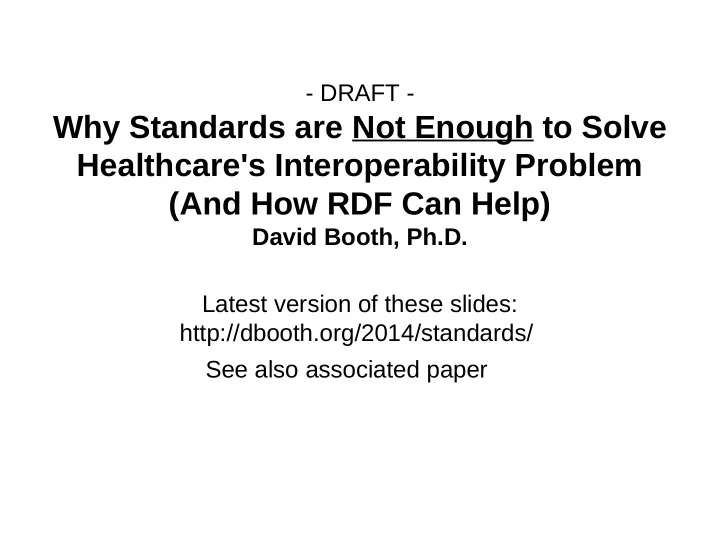

- DRAFT - Why Standards are Not Enough to Solve Healthcare's Interoperability Problem (And How RDF Can Help) David Booth, Ph.D. Latest version of these slides: http://dbooth.org/2014/standards/ See also associated paper
Definition Semantic interoperability: The ability of computer systems to transmit data with unambiguous, shared meaning. – Wikipedia
Healthcare today Tower of Babel, Abel Grimmer (1570-1619)
Obviously we need standards. And yet . . . .
How Standards Proliferate http://xkcd.com/927/ Used by permission
Standard Vocabularies in UMLS AIR ALT AOD AOT BI CCC CCPSS CCS CDT CHV COSTAR CPM CPT CPTSP CSP CST DDB DMDICD10 DMDUMD DSM3R DSM4 DXP FMA HCDT HCPCS HCPT HL7V2.5 HL7V3.0 HLREL ICD10 ICD10AE ICD10AM ICD10AMAE ICD10CM ICD10DUT ICD10PCS ICD9CM ICF ICF-CY ICPC ICPC2EDUT ICPC2EENG ICPC2ICD10DUT ICPC2ICD10ENG ICPC2P ICPCBAQ ICPCDAN ICPCDUT ICPCFIN ICPCFRE ICPCGER ICPCHEB ICPCHUN ICPCITA ICPCNOR ICPCPOR ICPCSPA ICPCSWE JABL KCD5 LCH LNC_AD8 LNC_MDS30 MCM MEDLINEPLUS MSHCZE MSHDUT MSHFIN MSHFRE MSHGER MSHITA MSHJPN MSHLAV MSHNOR MSHPOL MSHPOR MSHRUS MSHSCR MSHSPA MSHSWE MTH MTHCH MTHHH MTHICD9 MTHICPC2EAE MTHICPC2ICD10AE MTHMST MTHMSTFRE MTHMSTITA NAN NCISEER NIC NOC OMS PCDS PDQ PNDS PPAC PSY QMR RAM RCD RCDAE RCDSA RCDSY SNM SNMI SOP SPN SRC TKMT ULT UMD USPMG UWDA WHO WHOFRE WHOGER WHOPOR WHOSPA
Standard Vocabularies in UMLS AIR ALT AOD AOT BI CCC CCPSS CCS CDT CHV COSTAR CPM CPT CPTSP CSP CST DDB DMDICD10 DMDUMD DSM3R DSM4 DXP FMA HCDT HCPCS HCPT HL7V2.5 HL7V3.0 HLREL ICD10 ICD10AE ICD10AM ICD10AMAE ICD10CM ICD10DUT ICD10PCS ICD9CM ICF ICF-CY ICPC ICPC2EDUT ICPC2EENG ICPC2ICD10DUT Over 100! ICPC2ICD10ENG ICPC2P ICPCBAQ ICPCDAN ICPCDUT ICPCFIN ICPCFRE ICPCGER ICPCHEB ICPCHUN ICPCITA ICPCNOR ICPCPOR ICPCSPA ICPCSWE JABL KCD5 LCH LNC_AD8 LNC_MDS30 MCM MEDLINEPLUS MSHCZE MSHDUT MSHFIN MSHFRE MSHGER MSHITA MSHJPN MSHLAV MSHNOR MSHPOL MSHPOR MSHRUS MSHSCR MSHSPA MSHSWE MTH MTHCH MTHHH MTHICD9 MTHICPC2EAE MTHICPC2ICD10AE MTHMST MTHMSTFRE MTHMSTITA NAN NCISEER NIC NOC OMS PCDS PDQ PNDS PPAC PSY QMR RAM RCD RCDAE RCDSA RCDSY SNM SNMI SOP SPN SRC TKMT ULT UMD USPMG UWDA WHO WHOFRE WHOGER WHOPOR WHOSPA
Why are standards not enough to solve the problem?
Why does this happen? • Standards are imperfect – Version n+1 improves on version n • Diversity of needs – Different uses require different data – Different uses require different granularity • Problem complexity • Committee size • Changing requirements • Medicine and technology do not stand still! • Proprietary standards • Legacy systems • Risk mitigation
Software trilemma: Pick any two
Standards trilemma: Pick any two • Comprehensive: Handles all use cases • Good: High quality • Fast: Completed quickly
The granularity dilemma Complexity Simplicity Coarse Fine Granularity Blood Pressure: Blood Pressure: 120/70, sitting, 120/70 left_arm, Dinamap_8000 • Different uses need different granularities
Why standards and innovation? • Dilemma: Standards are necessary for semantic interoperability, BUT standards are a moving target – Medical science and technology are continually changing – Medicine is too big and diverse to suddenly adopt one monster standard – UMLS lists over 100 vocabularies! • Change is the norm!
Embracing standards and innovation A universal healthcare exchange language MUST: • Leverage existing and future standards – both de facto and de jure • Support decentralized innovation – new terms, vocabularies and data models • Allow continual incorporation of new standards • Support a graceful transition from innovation to standard – without re-tooling • RDF is the best available candidate!
Why is it so difficult to standardize? • Healthcare information is complex • Lack of incentive • Standardization takes time – Progress goes toward zero as committee size grows • Moving target: medical science and technology continually changing
Key requirements • Continually incorporate new vocabularies and data models • Support existing and future healthcare standards • Support decentralized innovation
Why include non-standard concepts? • Important to send all requested information in machine-processable form • Receiver may be able to use it • Helps bootstrap standardization
Additional requirements for graceful adoption of new concepts • Enable new concepts to be semantically linked to existing ones • Enable authoritative definitions of new concepts to be obtained automatically Best available candidate: RDF
What does semantic interoperability involve? • Machine processable information • Common vocabularies • Unambiguous concepts
Why is this so difficult to standardize? • Healthcare is complex: thousands of interrelated concepts, many domains • Standardization progress diminishes toward zero as committee size grows • Moving target: medical science and technology continually changing
Role of a common language Universal Healthcare Exchange Language
Role of a common language Universal Sender1 Healthcare Exchange Receiver Language Sender2
Semantic relevance is relative • Blood Pressure measurement: – Sitting versus Standing • Is the difference semantically relevant? • Depends on the application! • v:BP_Machine rdfs:subClassOf v:BP . • v:BP_Manual rdfs:subClassOf v:BP . • { ?bp a v:BP_Machine . } => { ?bp a v:BP . } .
Recommend
More recommend